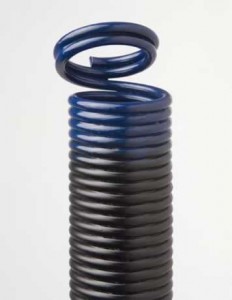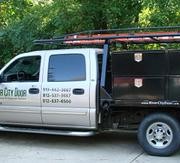Garage Door Springs 101
Garage door springs are a critical part of the operation of your garage door. Garage door springs are used to counterbalance the full weight of the garage door so that it can be lifted and closed easily and safely. A manually operated garage door that is properly balanced will not drift up or down. It will:
- Rest squarely on the floor in the closed position without drifting up
- Hang half-way up without drifting up or down
- Remain in the fully open position without drifting down
If your garage door is properly balance, it should take equal force to open and close the garage door.
What are the different types of garage door springs?
There are two types of springs used on residential garage doors today: Extension Springs and Torsion Springs.
Extension Springs
Extension Springs are a pair of stretched springs that run parallel to the tracks on both sides of the garage door. Extension springs lift the garage door using a counterbalance system of pulleys and cables. When the garage door is lifted, the springs contract as tension is released.
Torsion Springs

Torsion Springs are the most popular form of springs used today for residential garage doors. They are typically located just above the top section of the garage door inside of your garage. Depending on the weight and size of your garage door, a torsion spring system consists of either one or two torsion springs. Unlike extension springs, torsion springs are wound and do not expand or contract when the door is moved.
How long does an extension spring or torsion spring last?
Extension springs and torsion springs have a life cycle. The majority of garage doors come from the manufacturer with springs that are rated at 10,000 cycles. So, you may be asking yourself, what is a cycle? One cycle refers to each time you open and close your garage door. If you open and close your garage door many times a day, the life of your extension spring will be shorter than if you open and close your garage door once or twice a week. With average use, a homeowner can expect their springs to last anywhere between 5 and 7 years.
Which is better – Extension Springs or Torsion Springs?
While both types of springs do a great job in lifting your residential garage door, we believe torsion springs can be a better choice. Torsion springs tend to balance the weight of your garage door better than extension springs. This means smoother and safer operation of your garage door.
Fortunately, our partner and garage door manufacturer has developed a short but sweet video regarding garage door spring systems. We think it’s worth a look. Watch the Amarr spring video to learn more.
Are you thinking about installing your own garage door springs? Read this first and then decide.
If you’re reading this blog, then you are probably pretty serious about understanding your garage door better and maybe even thinking about installing your own garage door spring system. There are plenty of how-to videos and articles on the web that talk about how to install your own garage door springs. That being said, we highly recommend that you contact a trained garage door professional to install your new springs for the following reasons:
- Installing a garage door spring is very dangerous. Garage door springs operate under extreme tension. In an uncontrolled release of this tension, the energy is sufficient enough to maim or even kill the installer. It can also damage the garage door and contents of your garage. Professional garage door service technicians install garage door springs on a daily basis. They are knowledgeable about which springs to install and are experts in installing springs correctly, quickly and most importantly, safely.
- Convenience. If you’ve never installed a garage door spring before, it can be quite an undertaking. You will need to research how to do the installation, purchase the springs, remove the old springs and then install the new springs. A professional garage door repair company can install a new set of torsion or extension springs usually within one hour. This convenience is hard to beat, especially if your car is inside the garage and you need to get somewhere!
- Cost. Specific tools are required to install garage door springs correctly. Without them, the installation process is even more dangerous. Be sure to factor that in if you are still thinking about doing it yourself. The good news is that professional garage door repair is reasonably priced. Typically, the costs associated with professional spring installation for residential garage doors are approx. $125 – $250 depending on type and number of springs needed. These costs usually include the price of the spring, labor and trip charge. Be sure to check your garage door repair company’s website for coupons and discounts. Some even offer senior citizen and military service discounts.
Do I have to replace my springs when a new garage door is installed?
The short answer is… Yes! The long answer explains why. Here it is: A new garage door will be a different weight than your old garage door – even though it’s probably the same size. To lift and balance the new garage door correctly, the right type of spring needs to be installed. If the right type of spring is not used, the new garage door can become a danger to yourself, your loved ones and the contents of your garage.
If you are a purchasing a new garage door from a professional garage door company, new springs and related hardware should be included in the installation.
For fast, professional, dependable garage door spring installation call River City Door at 513-662-3667 or 812-637-6500 or contact us online. River City Door proudly serves Greater Cincinnati, Southeast Indiana and Northern Kentucky communities.




